|
CENTRAL
ISLIP: Opened: 11/4/1873 to replace “Suffolk” Station further
west. (see MP42-43 map below) Remodeled c.1916, Razed: 8/1958
2nd
Depot
Built: 1958. Agency Closed: ? Depot Closed: 1987
3rd
Depot
Relocated 1,700’ east of former location on south side of main track
with high level platforms in service: 11/16/1987. Facilities on north
side of passing siding in service: 12/14/1987
Research:
Dave Keller
|

Emery map Central Islip MP42-43
10/1957 Archive: Dave Keller
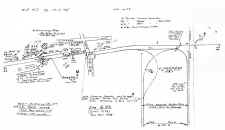
Emery map Central Islip
MP43-44 10/1957 Archive: Dave Keller
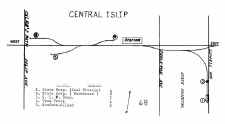
LIRR map Central
Islip 1966
|
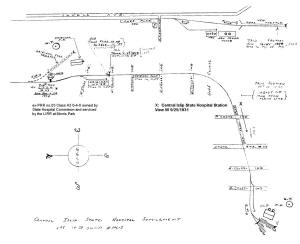
Emery map #ML-1 Central Islip State
Hospital 10/1957
Archive: Dave Keller
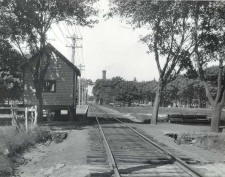
"X" above: Central Islip State Hospital Station - View W towards
Carlton Ave (Rte. 111) 9/25/1931 (F. J. Weber-Dave Keller)
|
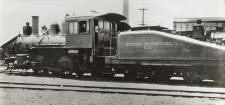
C.I. State Hospital Class A3 (0-4-0) drill engine no.3
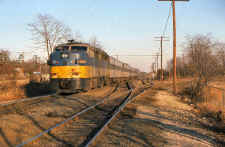
FA1 #615 Push Pull train eastbound Central Islip State
Hospital
(CISH) siding spur view E 12/23/78
(William Madden photo, Dave Keller archive
)
This
photo shows the track configuration as the spur led off the siding and NOT off the main.
Additionally, the additional siding eastbound off the SPUR creating that
odd-looking curve to the tracks.
View is looking east. Train is
eastbound. You can just make out the engineer's silhouette in
the door window of the GP38-2 at the east end and there are no
headlights lit on the FA1 unit.
|

|
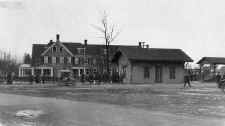
Central Islip station is seen here in this cold, gray, winter's
day c. 1922 view looking southwest from the intersection of Wheeler
Road / Carlton Avenue and Suffolk Avenue. It's train time and
the scheduled westbound is about to make the station stop as block
operator George G. Ayling focuses his Kodak 122 format folding camera
on the scene. In the background is Fisher's Hotel, a landmark across
from the depot for many years. At the far right is the old
open-air express house for westbound trains. Several years
later, this structure was rebuilt and enclosed for security issues and
by the 1930s, enlarged, probably to accommodate the increased express
business. Dietz kerosene platform lamps are evident in this
image. (Dave Keller archive)
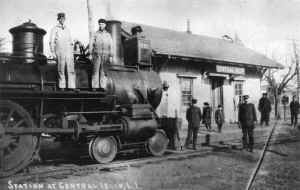
Engine #521 and crew at
Central Islip Station c.1905
Archive: Art Huneke
|
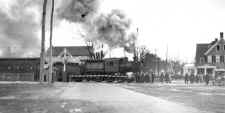
It's train time at Central
Islip. Block operator George G. Ayling has just photographed the depot
scene and is in the process of walking back across Suffolk Avenue to
resume his duties at the station when he turns and captures westbound
G54sb camelback #13 as it pulls a train of old wooden passenger cars
across the Carlton Avenue crossing in this view looking south from
Suffolk Avenue c. 1922. Notice the old wooden pole gates with
crossing watchman's shanty as well as the fireman taking a momentary
break, standing on the open platform behind the boiler. The
G54sb camelbacks were dual-service 10-wheelers (4-6-0) and as such,
were used in both freight and passenger service. The arrival of
the G5s passenger locomotives and the ex-PRR H10s (2-8-0) freight
locomotives around that time sounded the death toll for the camelback
locomotives in LIRR service and this locomotive and its sister engines
would be sent to the scrap yard by the end of the decade. (Dave Keller
archive)
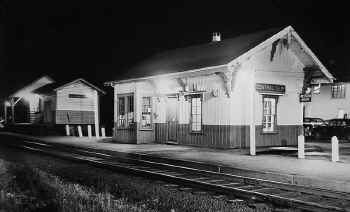
Central Islip Station/Express House
1952-53 view NW
Photo: Dick Wetterau
|
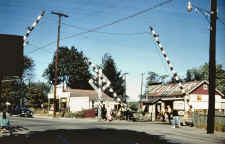
Central Islip at Carlton Ave. view SE c.1953 Photo: Art Huneke
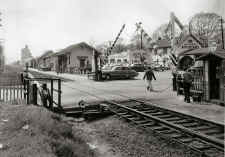
Central Islip Station 05/1954 view west
Archive: Jim Gillin
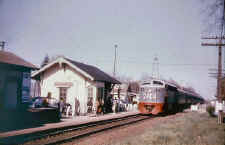
Fairbanks-Morse Model CPA24-5 diesel #2404 is westbound making the
station stop at the Central Islip station c. 1954. The
locomotive is sporting the "Tichy" color scheme. (Archive
unknown. Dave Keller data)
|
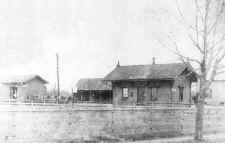
Looking northwest from
Carlton Avenue we see the old Central Islip station building as it
looked c. 1885. Notice the fancy gingerbread at the corners of
the roof ridge and the large, enclosed express house at the far left.
Between the two structures is a shed for horse-drawn wagons to be
parked. This shed lasted up into the 1950s. (George G.
Ayling collection, Dave Keller archive and data) |
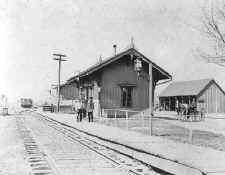
We see another view of the old Central Islip depot, express house
and wagon shed as the area looked c. 1895. On the platform in
the foreground is a Dietz kerosene platform lamp with ornate bracket
and standing in LIRR uniform is the station agent, Frank Kelly, who
was agent at Central Islip until 1923 when block operator George
Ayling was promoted to agent there. This wonderful vintage view is
looking west. (George G. Ayling collection, Dave Keller archive
and data)
|
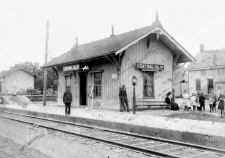
Central Islip Station - Agent Frank Kelly c.1910 Archive: Dave
Keller
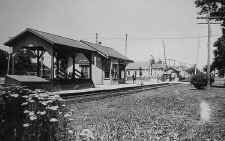
Central Islip - Express House/Station view NE c.1925
|
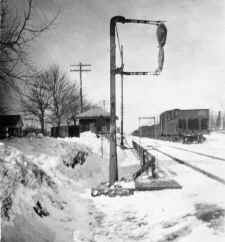
Looking west after a heavy
snowfall in 1916, we see the mail crane and "CP"
interlocking cabin. The mail crane has a U. S. Mail bag
suspended from the frame and is in position for a moving train to
capture the bag via the Railway Post Office car as it heads through
Central Islip. The low, slat fence along the tracks kept
mailbags tossed off the train for mail delivery to the Central Islip
Post Office from bouncing and going back under the wheels of the
moving train. "CP" cabin was constructed for the block
operator to handle the semaphore signals, but after building the
structure, the railroad decided it would behoove them to pay the block
operator a slightly higher salary and let him stay in the ticket
office to handle both the train traffic as well as ticket sales.
This cabin, named but never placed in service, was loaded onto a
flatcar and taken further east to the newly-created Upton Junction in
1917 to handle the block signals at the rail entrance to the U. S.
Army's newly-constructed Camp Upton. (George G. Ayling photo,
Dave Keller archive and data) |
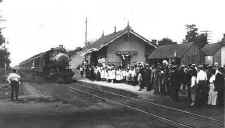
On September 8, 1910, the
first train from the newly-opened Pennsylvania station in Manhattan
headed eastbound. It was an electric MU train and it was full of
the press and dignitaries and the fare was by special invitation only.
After coming out of the tunnel on the Long Island City side of the
East River, the train was broken into several sections, with each
section pulled by a steam locomotive along each of the LIRR's
branches. At each station in the system, large crowds gathered,
bunting was draped on the station and flags waved. In this
image, D16b #201 is pulling the Main Line section of this special
eastbound train non-stop past the Central Islip station. (George
G. Ayling collection, Dave Keller archive and data)
|
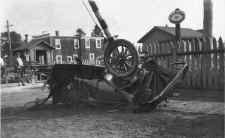
The crossing protection diamond-shaped wooden sign that was placed
at all railroad crossings stated "Railroad Crossing. Stop.
Look out for the Cars." In addition to these signs, some of
the busier crossings were manned by a crossing watchman who either
held up a "stop" sign for traffic and/or lowered crossing
gates. The Carlton Ave. crossing at Central Islip had the crossing
signs, a crossing watchman AND heavy pole gates to stop traffic.
Despite all this protection, we see the aftermath of an automobile
whose driver decided he'd ignore all of the above and try to beat the
train to the crossing. He lost. This view, taken c. 1920, is looking
northeast. In the left background is the crossing shanty which
protected the watchman from the weather and in the right background is
the eastbound express house. (George G. Ayling photo, Dave Keller
archive and data) |
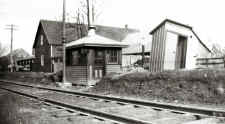
Here is a view of the newly-constructed "CP"
interlocking cabin and the Central Islip depot's two-stall outhouse as
it all looked in 1916. As mentioned previously, the cabin was
never placed in service and was loaded onto a flatcar the following
year, moved to Upton Junction, renamed "WC" cabin and used
to control train movements into and out of the newly-constructed U. S.
Army training facility at Camp Upton east of Yaphank. (George G.
Ayling photo, Dave Keller archive and data)
|
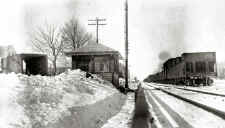
In the winter of 1916, we are looking due west at Central Islip
with "CP" interlocking cabin at the left and a freight on
the passing siding at the right. George G. Ayling, the block
operator, had rested his camera along the top wooden rail of the
protective fence used to keep the mailbags tossed off the moving
trains from bouncing back up and under the wheels of the train.
Notice the trench that has been dug in the snow so the mailbags could
be readily retrieved after delivery. (George G. Ayling photo,
Dave Keller archive and data)
|
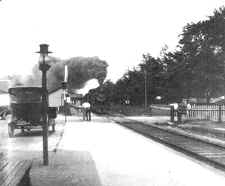
No . . that's NOT an ALCO
diesel heading west at Central Islip! Don't let the smoke fool
you! That's coal smoke and not diesel exhaust. It's a
class G53 ten-wheel freight locomotive which is pulling a heavy load
of cars and is smoking up the neighborhood. The single-length
pole gates are down across Carlton Avenue and a vintage open touring
car with top up is parked alongside the station platform in this 1916
image. (George G. Ayling photo, Dave Keller archive and data)
|
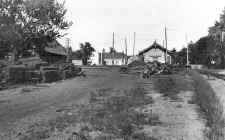
Some track work is in order and a shipment of railroad ties has
been delivered to Central Islip in this summer, 1916 view looking
east. In the distance, beyond the pile of ties at the right, is
the westbound express platform before it had a roof added to the
structure. Beyond that is the depot building, the pole gates at
the Carlton Ave. crossing and in the center background, the old,
wooden Episcopal church building. At the far left behind the other
pile of ties, is the old horse carriage stable. (George G.
Ayling photo, Dave Keller archive and data) |
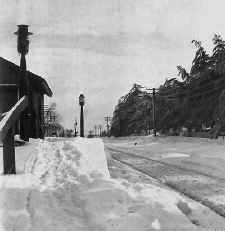
Looking east after an earlier snowstorm, this time in 1916, we see
the Main Line tracks have already had a train or two pass through and
there are a lot of footprints to and from the eastbound express house!
Two Dietz kerosene platform lamps are visible and beyond the distant
lamp, can be seen the westbound U. S. Mail crane. The Central
Islip State Hospital siding is buried under the snow at this point.
(George G. Ayling photo, Dave Keller archive and data)
|
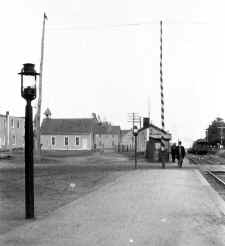
Looking east along the Central Islip station platform towards the
Carlton Avenue crossing c. 1918 we see the old Dietz kerosene platform
lamps, the single pole gate (one on either side of the tracks)
protecting the crossing, along with the crossing watchman and his
shanty. By the 1930s, these pole gates were replaced by a double
set of shorter pole gates on either side of the tracks. Beyond
the shanty is the eastbound express house and at the far right, it
appears a work train is on the Central Islip State Hospital siding.
The old Episcopal church building with steeple is visible to the left
of the express house. (George G. Ayling photo, Dave Keller
archive and data) |
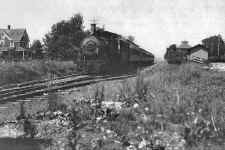
Looking west around 1920, we
see class D56 (4-4-0) #82 pulling a passenger train eastbound
approaching the Central Islip station. This class locomotive had
only a few more years of life left before it would be taken out of
service and scrapped, being replaced by the fleet of new, heavier and
much more powerful class G5s (4-6-0) passenger locomotives. In
the right background, we see a freight car spotted in front of the
freight house. The team track is to the far right. (George G.
Ayling photo, Dave Keller archive and data)
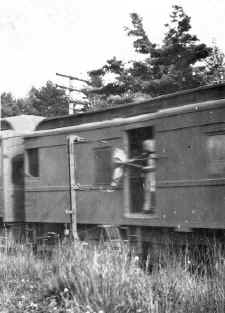
A Railway Post Office (RPO) car on an eastbound express train is
grabbing the mailbag off the mail crane as it whips through Central
Islip at 55 mph back around 1930. This view is looking
northwest. (George G. Ayling photo, Dave Keller archive and
data)
|
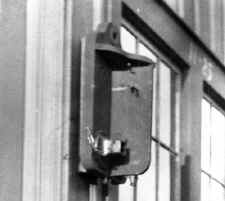
When a train order was sent by the dispatcher to a specific block
office, the block operator stationed at that office had to deliver the
train order to the specific train to whom the order was addressed.
His means of communication for this was to place a yellow-painted
metal and wood signal flag out for the train crew to see, so they
could slow down to catch the train order "on the fly" by
means of a train order hoop. At night, a yellow-globed kerosene
lantern (hand lamp) was used for this purpose. These signal
flags and signal lanterns were hung in a special bracket assembly
which hung on the wall of the block office. The brackets were
made of wood and contained a divider between the two sides, so that
the lit lantern at night could ONLY be seen by the train going in the
proper direction for the train order, to avoid any confusion as to
which train was to pick up the orders. During the day, this
problem was solved by the signal flag being painted yellow on the
"business" side and black with a line through it on the
other side. An eastbound and a westbound flag, painted on
opposite sides made up the matching set and either one would be placed
in the lower metal bracket seen in this close-up image of the assembly
on the exterior wall of the Central Islip station building ticket bay
window. The numbers visible atop the windows designated the fact
that the depot was last painted in November, 1925. (George G.
Ayling photo, Dave Keller archive and data)
|
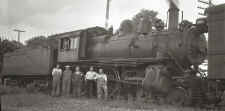
Once a year the little class
A3 switcher of the Central Islip State Hospital made a trip to the
LIRR's Morris Park Shops west of Jamaica for an annual inspection.
Additional trips were made if repairs were needed. When the
locomotive was being attended to, the LIRR replaced it with a relief
engine. Here we see LIRR class D16sb relief engine #228 and crew
in hospital service on the team track west of the Central Islip
station c. 1931. This view is looking northwest. (George
G. Ayling photo, Dave Keller archive and data)
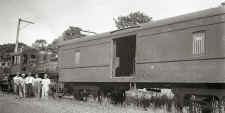
Photographed on the team track on the west side of the Central
Islip station, and looking northwest, we see the Central Islip State
Hospital's 0-4-0 switcher #03 and its LIRR crew. The
engine is coupled to an old LIRR Railway Express Agency (REA) car in
this 1933 view. (George G. Ayling photo, Dave Keller archive and
data)
|
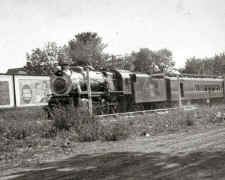
Station agent George G. Ayling captured with his camera G5s #21
pulling the LIRR name train "Sunrise Special" eastbound
through Central Islip c. 1927. The lead car is a PRR steel
combine. Locomotive #21 was assigned to pull this train. A
special logo was designed and painted on both sides of the tender.
The Montauk-bound train ran along the Main Line, accessing the south
shore to the Hamptons and Montauk via the Manorville-Eastport
connection. (Dave Keller archive and data) |
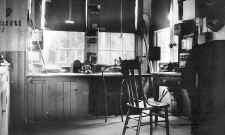
The interior of the Central Islip ticket/block office was typical
of many of the old, wooden, LIRR depots of the 1920s and 1930s.
In this image, taken around 1935, we see the ticket counter at the far
left with rubber destination stamps hanging on the wall along with a
ticket punch. At the far right was the station agent's desk and chair
and in the center of it all, was the block operator's bay window, and
desk, allowing him a full view in each direction down the tracks.
Originally equipped with armstrong levers to throw the semaphore
signals, this view shows a table model block machine (the box-like
item with the two rounded tops, behind the telephone) which allowed
the operator to change semphore signals with the flick of a small
lever on the face of the mechanism. The train order
"hoop" is on the bay window desk at the left, leaning
against the wall, telegraph and telephone equipment is visible around
the room and strips of flypaper are hanging down in front of the
windows. The employees working in these old offices never had
the comfort of air conditioning units. (George G. Ayling photo,
Dave Keller archive and data)
|
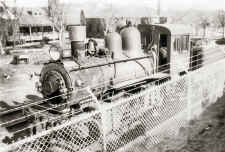
The Central Islip State
Hospital, which housed patients with mental conditions, was located
south of the tracks and east of the Central Islip station and Carleton
Avenue. There was a track spur that accessed the hospital for
deliveries of coal and supplies as well as passenger trains bringing
visitors to the hospital. For a period of time, the hospital
owned a former PRR class A3 (0-4-0) switcher locomotive which would be
used to switch cars in and out of the hospital grounds. It bore
the road number 03 and the tender was lettered "Central Islip
State Hospital." It was manned by a LIRR crew and the
locomotive's annual inspection and repairs were done at the LIRR's
Morris Park Shops west of Jamaica. By 1935 it had been taken out
of service as can be seen in this April 25th view of the locomotive
laying up along the fence on the hospital grounds. (Art Huneke
archive, Dave Keller data)
|
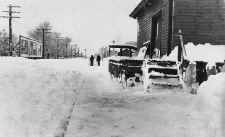
It's been one heavy duty snowstorm as we can see in the westward
c. 1935 view and the Central Islip station employees have just
completed a lot of shoveling to clear off the platform as well as the
stairs and high-level express platform at the westbound express house.
Judging by the condition of the right-of-way at the left, there won't
be any trains passing through here any time soon, until either a wedge
plow or the rotary has been dispatched. If the rotary is sent
out, chances are it will toss the snow to the south side of the
tracks. Of course, if the wedge plow comes through, all bets are
off and these men will be re-shoveling that platform! (George G.
Ayling photo, Dave Keller archive and data)
|
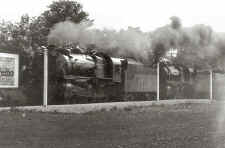
It's a hot summer's evening in 1930 and train #12, the "Shinnecock
Express" is heading eastbound, non-stop, through Central Islip
being pulled by a double-header of class G5s ten-wheeler locomotives.
This train, like the previous images, would traverse the
Manorville-Eastport connection to reach the Hamptons, Amagansett and
Montauk along the south shore. These Montauk-bound trains were
usually pulled by a pair of G5s locomotives as there was a weight
restriction over the old, rickety, steel trestle that spanned the
Shinnecock Canal at Canoe Place. In 1931, the old bridge was
replaced by a much heavier structure, which is still in place today,
and, as a result, these Montauk trains would be pulled by a single
Pennsylvania Railroad class K4s locomotive. As a result, the
replacement bridge over the Shinnecock Canal was popularly referred to
by just about everyone for many years as "the K4 bridge."
(George G. Ayling photo, Dave Keller archive and data)
|
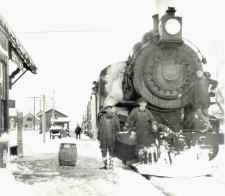
Rarity of rarities!
George G. Ayling worked at the Central Islip station from about 1910
until he retired from the LIRR in 1954. While he took a number
of railroad photos he didn't manage to take as many as he COULD have
taken in that time frame. But when you consider the images that
he DID take, it is amazing. First, we see the only known images
of the never-used "CP" cabin. Then we see images of
the "Sunrise Special" speeding through the quiet village.
And now, on a cold, dreary, snow-and-ice-filled day c. 1929, we have
an amazing photo of H6sb locomotive #304 and her crew posing on a
westbound freight in front of the depot (yes . . and blocking the
crossing while everyone hams it up for the camera! So
. . . what's so special about this nice shot, you may ask. Well,
it seems that H6sb #304 "disappeared" from the roster around
1931 and nobody knows whatever happened to her. What's more,
George Ayling seems to have been the only person to ever have
photographed her, either in service or out, so this is a one-shot
deal. A photo of a "ghost" locomotive that one day
just vanished. (George G. Ayling photo, Dave Keller and Art
Huneke archive, Dave Keller data)
|
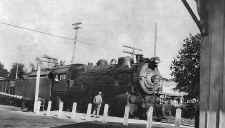
H10s #103 is pulling an afternoon freight westbound through
Central Islip c. 1930. The brakeman is on the platform, probably
preparing to throw the switch as the freight passes by, so it can
access the siding for the Central Islip State Hospital. Notice
the locomotive is flying white flags! This view is looking
southeast with the pole gates at the left protecting the Carlton Ave.
crossing. The corner of the depot building is in the right
foreground. (George G. Ayling photo, Dave Keller archive and
data)
|
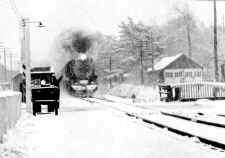
The snow is falling and visibility is getting poorer by the minute
as a G5s locomotive pulls a passenger train westbound through Central
Islip c. 1930. The snow is sticking to the pilot beam and pilot,
highlighting the metal lattice. The crossing watchman is waving
to the engineer as he awaits the train to pass so he can raise the
double sets of pole gates guarding the Carlton Ave. crossing.
(George G. Ayling photo, Dave Keller archive and data)
|
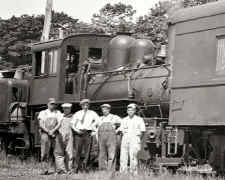
This view is a close-up of the little class A3 Central Islip State
Hospital drill engine #03 and its crew posing on the team track behind
the CI freight house west of the depot around 1931. (George G.
Ayling photo, Dave Keller archive and data) |
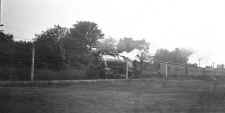
A Pennsy K4s class
locomotive is pulling a late summer afternoon Montauk express train
eastbound through Central Islip c. 1933. Although still a
distance from the Carlton Ave. crossing, the engineer is not making
the station stop and is blowing the whistle because at his speed,
he'll be at that crossing in seconds. (George G. Ayling photo,
Dave Keller archive and data) |
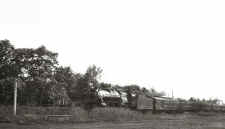
Another Pennsy K4s class
locomotive is pulling another late summer afternoon Montauk train
eastbound through Central Islip c. 1933. As is the case with the
previous image, both Montauk trains will head towards the south shore
via the Manorville-Eastport connection, making stops at the Hampton's,
Amagansett and Montauk. (George G. Ayling photo, Dave Keller
archive and data)
|
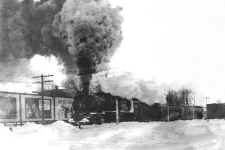
With snow nearly above the
pilot beam, a Pennsy class K4s locomotive is pulling a Montauk train
eastbound through Central Islip in the aftermath of yet another heavy
Long Island winter snowstorm. Smoking away while trying to
maintain traction and pull the long train, the engineer has got a
heavy hand on the whistle cord as he blows for the Carlton Avenue
crossing up ahead. The billboard behind the locomotive's
smokebox is advertising the 1933 Chicago World's Fair. (George
G. Ayling photo, Dave Keller archive and data) |
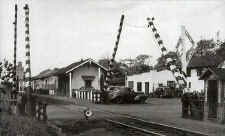 This northwest photo view of the station facilities is c.1950. The Grange League Federation (GLF), 85’ grain elevator tower, built in 1938, processed and stored feed and grain. (Photo:
center left) This northwest photo view of the station facilities is c.1950. The Grange League Federation (GLF), 85’ grain elevator tower, built in 1938, processed and stored feed and grain. (Photo:
center left)
The switch target in the foreground identified the switch for the Central Islip State Hospital siding/spur.
Note the highly unusual pole gates; located nowhere else on the LIRR except here at Carlton Ave.
The Express House serviced express shipments. The Crossing Shanty for the Crossing Watchman in the right foreground, was occupied between train runs during inclement/cold weather. Wilbur Pearsall and later John Zimmerman held this position. Johnson's Garage is across the road.
|
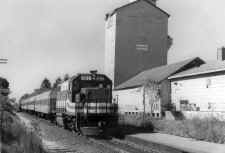
AGWAY (ex-GLF since 7/25/1964)
grain elevator - Central Islip view W 10/14/1980 Archive: Dave
Morrison
|
|
GLF commodity groups (feed, seed, fertilizer and chemicals, petroleum, and farm hardware) as well as market for the farmer huge volumes of eggs, grain, and dry beans. |
| |
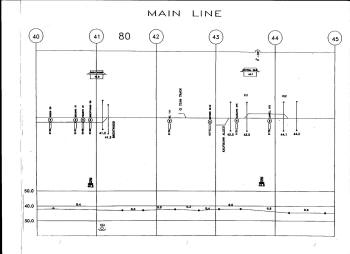
Main Line - Brentwood to Central Islip Track profile map 1994 |
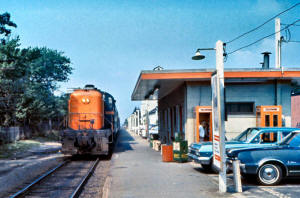
Central Islip Station - RS3 #1559 eastbound Train #204 on 8/01/1967
Note the GLF elevator mostly hidden behind the station.
Photo/Archive: Richard F. Makse |
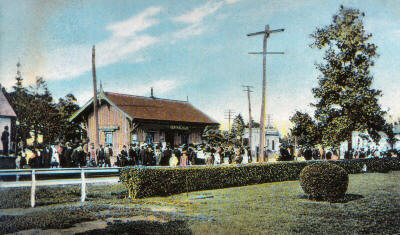
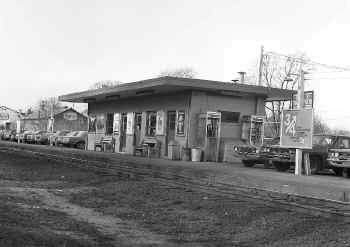
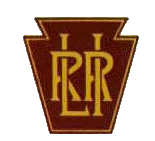 Central
Islip
Central
Islip 














































